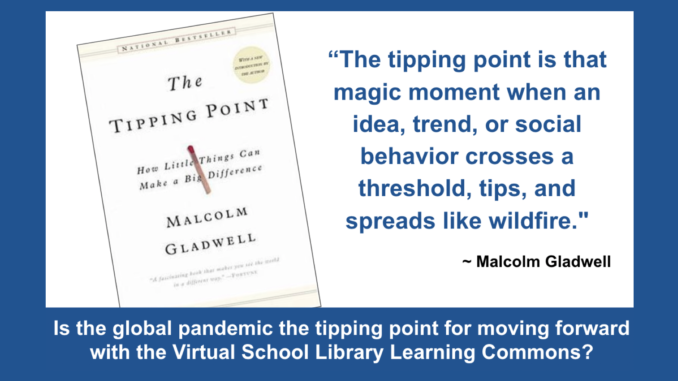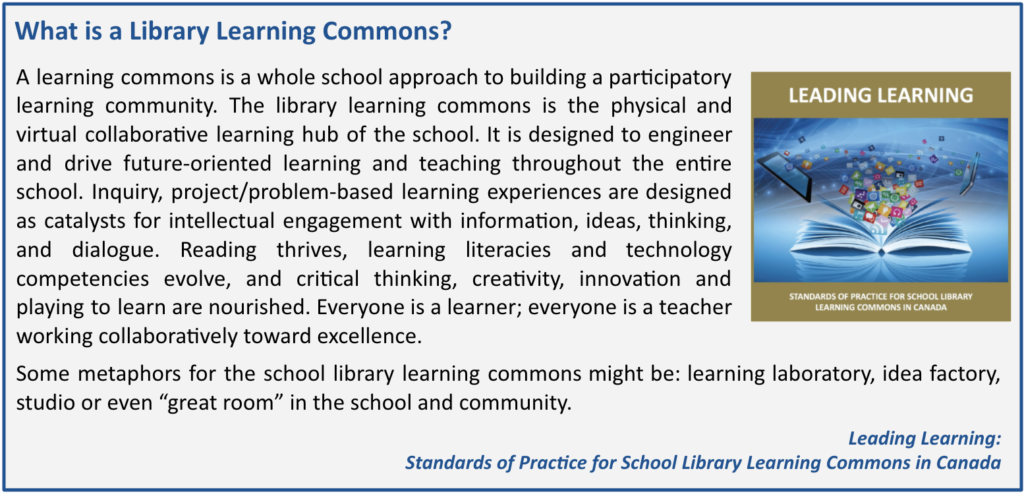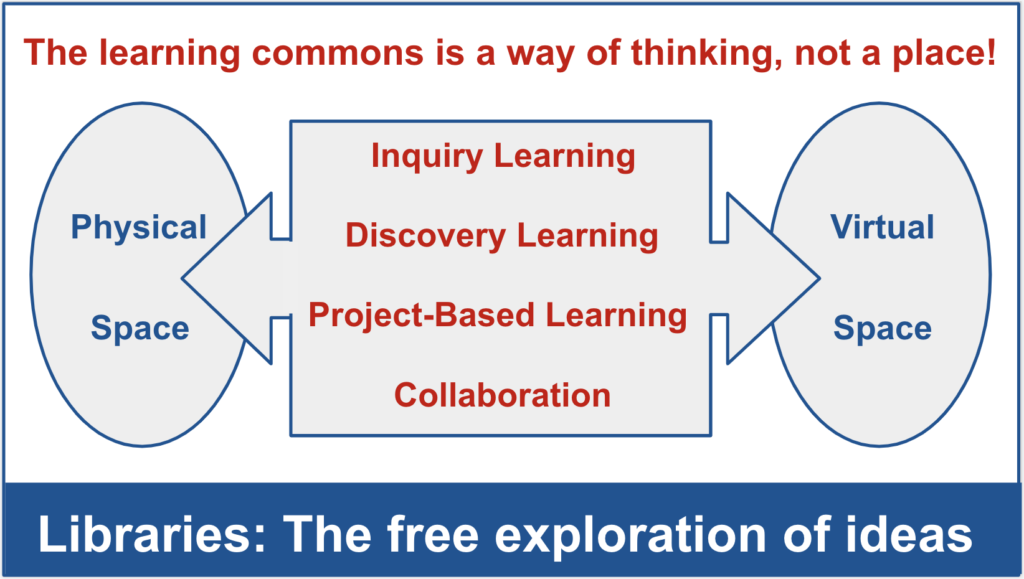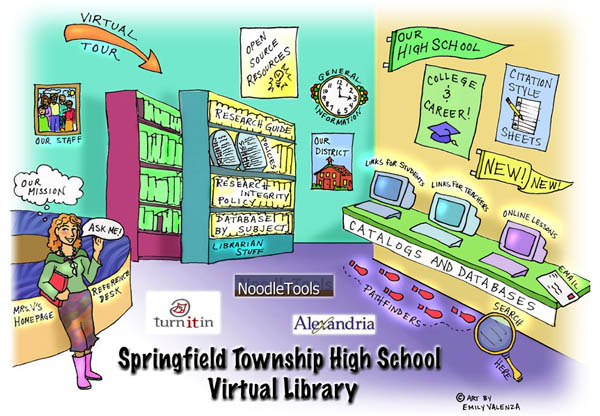
By Anita Brooks Kirkland
The virtual school library learning commons. This is not a new idea, but it is an idea that has not caught on as well as many had hoped. While there are many great examples of schools and districts implementing the vision or part of the vision for the virtual library learning commons (VLLC) as a vibrant learning space, all sorts of constraints have prevented widespread implementation.
But now in 2020, things have changed radically. With widespread school closures during the global pandemic, libraries either find ways to serve their school communities online or risk losing relevance. The constraints that had made people reluctant to take this step before seem inconsequential compared to the prospect of remaining offline. We are at the tipping point. If we are not online we do not exist.
Even when school resumes it will not be back to normal. The shorter-term new normal is likely to include significant restrictions to how the library space is used. The virtual program will retain its importance in this changing environment, and may indeed evolve in ways we cannot yet imagine. Physical distancing means relying on ways to integrate the physical and virtual spaces of the school library. Most importantly, making connections with teachers and students in the online environment becomes increasingly critical to the library program’s success. Shifts in practice in this time of crisis will have long-term implications. We need to leverage this great opportunity: necessity is indeed the mother of invention.
In the midst of the pandemic we are seeing wonderfully inventive educators finding innovative ways to support students and teachers. Online professional learning networks abound with wonderful examples of online curations, including engaging “choice grids” and “Bitmoji classrooms”. Professionals are collaborating to build new online spaces and resources together. Teacher-librarians are participating in online classrooms in course management systems, co-teaching for inquiry and helping readers engage even when they can’t access “real” books. The urgency is palpable. Let this be the beginning of realizing the full potential of the post-pandemic school library learning commons, where critical thinking, inquiry, reading, multiple literacies, curiosity, design thinking, and making thrive in the information-rich, collaborative learning space of the physical AND the virtual library space.
Key Understanding: Learning Commons Thinking
The learning commons is a philosophy that puts the library at the centre of a whole school approach to participatory learning. Understanding the learning commons only as the design of a space misses the point. Just like the physical space, the virtual space is a catalyst for the participatory learning that is at the core of learning commons thinking. We must fully understand this concept in order to realize the space’s full potential. Design factors in the physical space exist to facilitate inquiry, discovery, and collaboration, and so should design factors of the virtual space.

We have almost universally moved beyond understanding the physical space of the library as an information warehouse – a place where we go to find information and then leave. We understand the physical space of the library as a learning hub, and so must we design virtual spaces that yes facilitate access to resources, but also facilitate access to learning experiences and teaching expertise. The virtual space is flexible, far-reaching and dynamic. It extends the reach of the library into classrooms, students’ homes, and extended communities. It complements and enhances learning in the physical space of the library and the school. The virtual library space has never been more essential, and now is the time to leverage the pandemic tipping point to make it a universal part of the library learning commons.
The Multiple Facets of the VLLC

The school library’s main website is extremely important, and serves as a hub for presenting resources, connecting to collaborative spaces, demonstrating accountability, and making the library program visible to the school community and beyond. The school library website should integrate central library resources and services offered online as seamlessly as possible. Viewing the website as a virtual hub – a platform for connecting people with opportunities – may help understand its potential.
A rich and usable website is the hub, but the virtual library’s reach could extend into other platforms. Collaborations might take place within a course management system, or in online collaborative environments such as a Google doc or sheet. Various other technologies might be used for different purposes: a book club might use FlipGrid, for example, or student feedback might come via a Padlet. Some virtual spaces will be public, and others will be protected in order to observe copyright guidelines, adhere to licensing agreements, or to protect student privacy in online learning spaces. The virtual library’s reach may extend into online professional learning networks. Social media may provide a way to connect with students, parents, and the extended school community.
It is key to understand the virtual environment as offering unique and extended opportunities for consuming, sharing, creating and engaging in discussion. The virtual world opens up vast resources and social connections for learning. Opportunities for integrating multiple literacies abound. “We are entering an era where it becomes possible for everyone to read the book simultaneously, write about it, discuss it, do mashups about it, build creative media around it, and even further elevate the experience by spinning off into our own writings.” (Loertscher, Koechlin, & Rosenfeld, 2012).
The virtual library learning commons may include many functions:
Resource Access:
- Catalogue & database access: Access to quality resources is a key function of the library. Digital catalogue interfaces offer a unique opportunity to engage users through effective design.
- Digital curation: Connections to the best resources selected by library professionals, via pathfinders or choice boards.
- Tutorials, tips sheets and organizers: Instructional resources to support inquiry and research, information literacy, media literacy, digital literacy – the process learning that is at the heart of library instruction.
Virtual Makerspace:
- Provocations to foster design thinking projects: virtual and hands-on
- Curated resources for digital making
- Connections to tech tools and tutorials for media constructions
- Digital galleries to showcase student creations
Participatory Learning Centre:

- Co-teaching within interactive online spaces
- Using online collaborative environments to enhance and extend face-to-face instruction
- Providing virtual programming like online book clubs
- Providing interactive opportunities to engage with experts, authors, and peers online
- Integrating multiple literacies: Developing digital and media literacy skills for being critical consumers of information online, while also providing opportunities for students to write and create in multiple media, and share with an authentic audience, within the school’s virtual environment and to the world
- Creating a hub for professional learning to share with colleagues
Community Space:
- Putting the library at the centre of building school culture
- Supporting and promoting library and school events
- Creating a school gallery and inviting participation
- Inviting students to contribute to all areas of the website
- Develop and feature community and global partnerships: using the virtual space to develop global competencies
Demonstrating Value:
- Sharing annual plans that highlight the library program’s unique contribution to achieving school goals
- Providing monthly and/or annual reports highlighting programs, collaborations, and statistics. Sharing qualitative data – what people think and say – as well as quantitative data.
- Most of all, the library needs to be visible. An effective school library is a go-to place in the school building – a hub of learning and activity. Ultimately, the same should be said for the virtual library, which should be a feature of the school’s website and online communications.
Design Factors in the Virtual Space
Modern library learning commons are designed to empower students. Clear signage promotes independence. Flexible furnishing fosters flexible learning. Collaboration spaces promote collaborative learning. Maker spaces encourage design thinking. Designing spaces and resource access through an equity lens creates a culturally responsive and inclusive learning environment. We understand the library learning commons as the third space where the environment influences how we learn. The same kinds of considerations should extend to the library’s virtual space.
Design functions that foster learning in the virtual library space:
Website Usability:
- Signposts and pathways: Provide clear navigation and menu structure. Make things easy to find. Avoid over-categorizing and nested pages that create unwieldy URLs
- Clear language: Use clear language and avoid bibliobabble or library lingo.
- Minimal language: Understand that people read differently in online spaces. Skimming and scanning is the norm. Clarity and conciseness are essential to good communication in online environments.
- Visual appeal: Images and graphics increase appeal and enhance usability in online environments.
- Accessibility: From alternate text for images to subtitles for videos, online environments provide multiple ways to make content accessible and create learning opportunities for all students.
- Bring learning in rather than sending learners out: Embed that video or that slide show into the website rather than sending users out of the library with a link.

Instructional Symbiosis: Leveraging unique opportunities in the virtual environment
- Just in time learning: Provide short learning objects – FAQs and/or “how-to” video tutorials for basic learning: ie, How to find other books in the series, How to reset your password, Using search filters in a database, etc, etc.. A rich collection of digital objects for just in time learning may help flip your library, so that precious face-to-face time can be used for deeper collaborative learning.
- Student agency: Have students create those learning objects: if they build it, they will use it!
- Integrate face-to-face learning with learning in the virtual environment: Use online forms for feedback and formative assessment; provide collaborative online spaces for inquiry projects; give every student a voice in the learning environment – including those who are reluctant to raise their hand in class.
Platforms & Places
There are so many web platforms these days – what should you use and where do you start?
- Use what’s available and supported: Use the platform that is supported in your school district. Yes, you may want to use the latest, greatest that people are raving about, but if it is not sanctioned by your school district, you may find yourself out in the cold, unpublishable, unsupported from an administrative and technical point of view, and vulnerable to misunderstandings around professional conduct.
- Use what works the best: Match the desired function with the most useful platform. The good news is that web authoring software is infinitely easier to use than it was back when we started this venture into the virtual library space so many years ago.
- Use multiple platforms: Your main website might be created using standard web-authoring software like WordPress or Google Sites. Learning objects might be created using embedded slide presentations or videos created with appropriate applications. Collaborative spaces may exist within course management systems or in protected online documents.
Remember, the virtual library is much more than your website: it is how you support and extend learning in virtual environments.
Physical / Virtual Symbiosis

the design of the physical library. Have the rest of us finally
caught up with her vision? Creating your virtual library(quickly)
using Slides and Bitmojis as Hyperdocs.
Image used with permission.
In today’s school library learning commons, the physical library and the virtual library should ideally be fully integrated, in all or at least some of the many ways suggested in this article. This is not a new concept, but one that is finally being realized – a timely meeting of necessity and capacity ignited by the realities of the pandemic.
Over the first two months of school closures social media networks have abounded with examples of interactive choice grids and Bitmoji classrooms. In a bid to help students feel connected in online classrooms, teachers are replicating familiar physical learning environments in the virtual space. Their creations recognize the power of design and visual appeal, yes, but more importantly they intuitively understand the learning environment, be that physical or virtual, as the third teacher.
I can’t help but recall the Ontario Library Association Super Conference way back in 2006. The Ontario School Library Association spotlight speaker was none other than Joyce Valenza, and her topic was the virtual school library. The vision she presented at that conference has influenced me profoundly. Now a university professor and respected scholar, at the time she was a practicing teacher-librarian. Her vision of an integrated physical and virtual library space both excited and frightened those of us gathered there that day. Remember, web authoring at that time was a complex and intimidating process, and here we were, being challenged to go down unfamiliar paths because that’s where we needed to be.
When I look at what educators are doing now with choice boards and Bitmoji classrooms, I can’t help but think that the rest of us have finally caught up with what Joyce Valenza was doing fifteen years ago!
Getting Started and Overcoming Barriers Through Collaboration
The greatest barriers to developing a virtual library are time and technology. I can’t count how many times that people tell me they don’t have the time, or that they find the technology too daunting. Yet here we are at a place where we either sink or swim. Without a virtual presence – whatever that may look like – we do not exist. There is nothing like just getting started for realizing potential and seeing the path forward. We are stronger and better when we work together, and this is particularly true when it comes to developing the virtual library learning commons.
- District-Wide Virtual Library: There are many examples of school districts providing excellent virtual library websites that provide access to centrally-licensed digital resources, school-specific access to the online catalogue, and centrally-developed instructional resources. At the very least, these websites should be visibly and prominently linked from every school website in the district. The virtual libraries of the Toronto District School Board and Thames Valley District School Board in Ontario demonstrate two approaches. (Brooks Kirkland & Loertscher, 2020)
- Centrally Developed Framework: Several school districts take the district-wide approach even further. The Regina Catholic School District, for example, provides a central template for every school library, which is integrated into every school website. Boardwide programs are featured, and every school’s teacher-librarian has an opportunity to build customized pages within the template, right on their own school website. (Brooks Kirkland & Loertscher, 2020)
- Boardwide Collaboration: Some school districts provide a central framework that fosters sharing between schools. The Saskatoon School District uses LibGuides to provide an online space for every school library to develop online instructional resources. School-level guides are available for using and sharing between schools and across the LibGuides network. The Peel District School Board in Ontario’s Bringing the LLC Home website invites teacher-librarians from across the board and beyond to develop their own “Learning Grids” and contribute them for sharing on the website. (Brooks Kirkland & Loertscher, 2020)
- Professional Learning: The sudden and dire need for developing virtual learning resources has inspired countless professional learning opportunities: free webinars, online discussions and sharing, board-level workshops – you name it, it’s out there! Even when “sheltering at home”, we all have opportunities to start or continue our own learning about developing the virtual library learning commons.
- Follow a Clear Path: At this point you may be feeling quite overwhelmed. So much to do! As with everything you need to pick your projects based on the most pressing needs. Figure out where you are and decide on next steps. Leading Learning: Standards of Practice for School Library Learning Commons in Canada provides a framework for implementation, tangible steps to build capacity, and exemplars from school libraries in Canada to help you imagine the possibilities.
The New Normal
“Will our new normal be libraries half empty by social distancing, or community hubs that extend beyond our socially distanced footprint to the kitchens and living rooms of every one of our community members?” So asks library visionary R. David Lankes (2020) as he ponders the post-pandemic library. Lankes encourages us not to succumb to the temptation to dwell on the negative, but rather to acknowledge that things are going to change, with an urgency on our part to shape that change.
For school libraries the symbiosis of physical and virtual learning commons frames our future. Lankes also suggests that shaping change means advocating for factors that in this new normal impede equitable access. Bigger issues like lack of universal broadband access, restrictive and expensive ebook licensing for libraries, and provincial/territorial licensing of e-resources, ensuring equitable access for all students, loom large as we imagine what the future of learning will be. Let us leverage this pandemic-induced tipping point, emerging as change leaders and innovators.
References
Brooks Kirkland, A. (2009). The school library learning commons: Are we “virtually” there? School Libraries in Canada 27(2). Accessed at: http://journal.canadianschoollibraries.ca/wp-content/uploads/2017/04/SLiCv27n2.pdf
Brooks Kirkland, A. (2009). The virtual library as a learning hub. School Libraries in Canada 27(3). Accessed at: http://journal.canadianschoollibraries.ca/wp-content/uploads/2017/04/SLiCv27n3.pdf
Brooks Kirkland, A. & Loertscher, D. (2020). Build your own virtual library learning commons. Resources to support a three-part webinar series for the Learning Revolution’s daily online worldwide education conference. Accessed at: https://www.bythebrooks.ca/build-your-own-vllc/
Canadian School Libraries (2020). Leading learning: Standards of practice for school library learning commons in Canada. Accessed at: http://llsop.canadianschoollibraries.ca
Gladwell, M. (2002). The tipping point: How little things can make a big difference. New York: Little Brown & Co.
Lankes, R. D. (April 30, 2020). The “New Normal” Agenda for Librarianship. Accessed at: https://davidlankes.org/the-new-normal-agenda-for-librarianship/
Loertscher, D., Koechlin, C. & Rosenfeld, E. (2012). The Virtual Learning Commons: Building a Participatory School Learning Community. Salt Lake City: Learning Commons Press.
Valenza, J. (May 14, 2020). Creating your virtual library (quickly) using Slides and Bitmojis as Hyperdocs. Neverending Search, School Library Journal. Accessed at: http://blogs.slj.com/neverendingsearch/2020/05/14/creating-your-virtual-library-quickly-using-slides-and-bitmojis/

As a writer, presenter and consultant, Anita Brooks Kirkland specializes in school library learning commons practices, program assessment, research, and advocacy. She draws on her extensive experience as a teacher educator, both as an instructor in teacher-librarianship for the Ontario Institute for Studies in Education (OISE), University of Toronto, and in her previous role as the Consultant for K-12 Libraries at the Waterloo Region District School Board in Ontario. Anita was a contributing writer to Together for Learning, Ontario’s guideline document for the school library learning commons. Anita is very active in professional organizations, currently serving as chair of Canadian School Libraries (CSL) and co-editor of the CSL Journal. She was the 2014 president of the Ontario Library Association, and also served as president of the Ontario School Library Association in 2005. Anita shares an extensive collection of program resources, articles, and presentations on her website and blog, www.bythebrooks.ca.